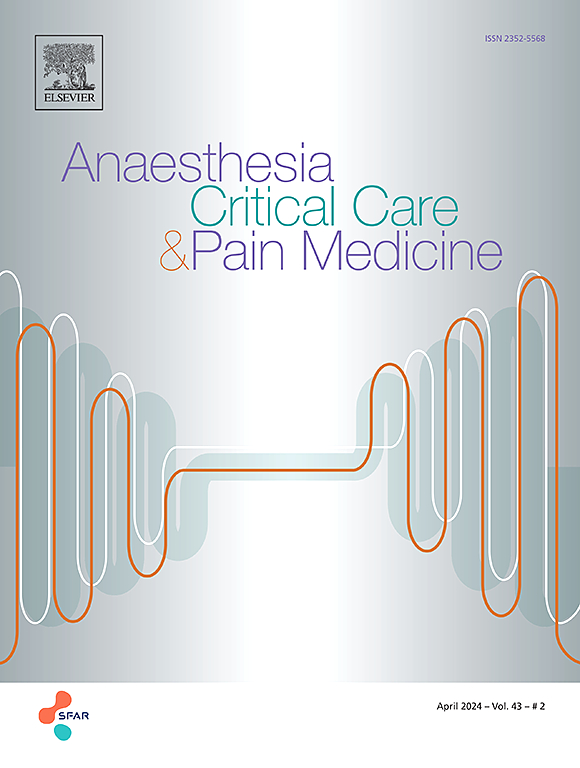Comparative analysis of patient and family satisfaction in Spanish Intensive Care Units: A cross-sectional study of the impact of diagnosis
IF 3.7
3区 医学
Q1 ANESTHESIOLOGY
引用次数: 0
Abstract
Background
Analysing relatives and patients experiences and satisfaction can highlight areas for improving Intensive Care Units (ICUs) care. Patients and families may differ about satisfaction and experience, depending on the diagnosis and procedures. We aimed to compare the experience and satisfaction of patients according to diagnosis, severity, and the procedures received, and also between relatives and patients.
Methods
Prospective analysis of voluntary responses to the FS (Family Satisfaction)- ICU 24 R questionnaire from surviving ICU patients and their relatives (January-April 2023) in four Spanish hospitals, according to diagnostic groups. Responses were scored on a Likert scale (0: worst score; 100: best score), and means and standard deviations were compared.
Results
185 responses were analysed, mostly acute cardiac pathology patients (91, 50.83%), followed by septic shock patients (22.9%). Patients rated the team performance higher than their relatives (98.79 ± 5.37 vs 89.68 ± 18.43; p < 0.0001), also symptom management such as pain (95.62 ± 9.52 vs 89.64 ± 17.24; p = 0.0001, and dyspnoea (94.23 ± 12.27 vs 88.09 ± 17.87; p = <0.001), the information process (91.50 ± 13.43 vs 83.17 ± 21.00; p < 0.001), and decision-making (80.38 ± 13.60 vs 65.84 ± 23.60; p < 0.001). Patients found visits to be scarce (43.75 ± 20.79), although their families were satisfied with their involvement in care (85.49 ± 19.64). Patients with sepsis and septic shock rated pain management the lowest compared to other diagnostic groups (sepsis/septic shock 89.58 ± 12.5 vs 98.61 ± 5.89; p < 0.001).
Conclusions
Open visiting policies and enhancing the protocols for conscious sedation/analgesia in invasive procedures are opportunities to improve the satisfaction and experience of ICU patients and their families.
西班牙重症监护病房患者和家属满意度的比较分析:诊断影响的横断面研究
分析亲属和患者的经历和满意度可以突出改进重症监护病房(icu)护理的领域。根据诊断和治疗程序的不同,患者和家属对治疗的满意度和体验可能会有所不同。我们的目的是比较患者的经验和满意度,根据诊断,严重程度,所接受的程序,并在亲属和患者之间。方法对西班牙四家医院(2023年1月至4月)ICU存活患者及其亲属自愿回答的FS (Family Satisfaction)- ICU 24r问卷进行前瞻性分析。回答采用李克特量表评分(0分:最差;100:最高分),并比较均值和标准差。结果共分析185例患者的反应,以急性心脏病理患者为主(91例,占50.83%),其次为感染性休克患者(22.9%)。患者对团队表现的评价高于其亲属(98.79±5.37 vs 89.68±18.43);P < 0.0001),疼痛等症状管理(95.62±9.52 vs 89.64±17.24;P = 0.0001,呼吸困难(94.23±12.27 vs 88.09±17.87;P = <0.001),信息处理(91.50±13.43 vs 83.17±21.00;P < 0.001)和决策(80.38±13.60 vs 65.84±23.60;p < 0.001)。患者就诊较少(43.75±20.79),但家属对其参与护理感到满意(85.49±19.64)。与其他诊断组相比,脓毒症和脓毒性休克患者对疼痛管理的评分最低(脓毒症/脓毒性休克89.58±12.5 vs 98.61±5.89;p < 0.001)。结论开放就诊政策,完善有创手术中有意识镇静/镇痛方案,可提高ICU患者及其家属的满意度和体验。
本文章由计算机程序翻译,如有差异,请以英文原文为准。
求助全文
约1分钟内获得全文
求助全文
来源期刊

Anaesthesia Critical Care & Pain Medicine
ANESTHESIOLOGY-
CiteScore
6.70
自引率
5.50%
发文量
150
审稿时长
18 days
期刊介绍:
Anaesthesia, Critical Care & Pain Medicine (formerly Annales Françaises d''Anesthésie et de Réanimation) publishes in English the highest quality original material, both scientific and clinical, on all aspects of anaesthesia, critical care & pain medicine.
 求助内容:
求助内容: 应助结果提醒方式:
应助结果提醒方式:


